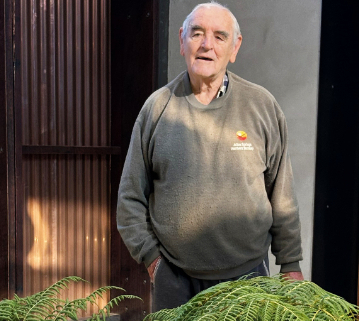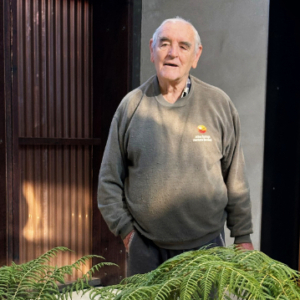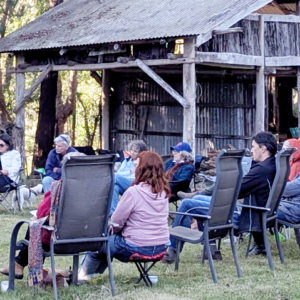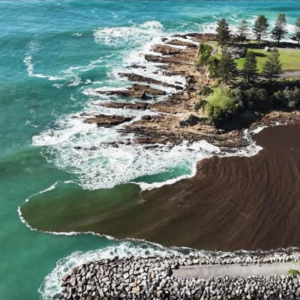My Triangle – Brian Ayliffe
 Brian Ayliffe and his ‘sort of museumy thing’
Brian Ayliffe and his ‘sort of museumy thing’
When I bragged to a neighbour that Brian Ayliffe was The Triangle podcast feature interview this month, she quietly said, ‘Brian is my hero. I would follow him anywhere. In fact, I did follow him into some pretty hairy situations when he was my captain in the fire brigade.’ Others made similar remarks about what Brian has done in this community making even more of an impact because of how he goes about things and engages with people.
Sitting at his cosy kitchen table, I learned that Brian came here in 1945 at age five or six when his parents bought the Cobargo General Store. ‘We sold groceries, but also drapery, televisions, washing machines, fridges and motorcycles! In fact, at one time, our store was the largest country Honda dealership in NSW. The store ran on accounts. The beef farmers would pay their account once a year after the spring sale. Dairy farmers had more regular income.
‘When the road to Bega was dirt, it was easier to shop in Cobargo. As roads were sealed and the population became more mobile, it made sense to get supplies in Bega, so the general store faded out. It was a pity, but it was just a fact of life. So, Mary and I started driving the school buses, which guaranteed early mornings, the very best part of the day.’
Mary had a terrific relationship with ‘her kids’ who she drove to school each day. ‘Years later, Mary made a point of going down town to collect our mail quite late in the day. I finally woke up as to why. Five o’clock is when the tradies came in for a beer before going home for tea. And the tradies were her kids. She just felt so connected with them from driving them to school for all those years.
‘When you’re in a small town, you’re in everything, but my one big passion was the fire brigade movement. Sixty-five years of service in the Rural Fire Service (RFS) kept me busy. The NSW Volunteer Fire Brigade is the largest firefighting organisation in the world, with 70,000 volunteers. Each of them is just an ordinary volunteer. When you’re called, you drop everything. When I had the bike shop, we would just close, also because my mechanic was my deputy captain.
‘We lost the old General Store premises in the Black Summer fire. We were insured so we were very fortunate. Public meetings were called, and nobody knew what to do. Where do we start? It felt almost impossible. A third of the business centre was wiped out and, economically, there was no fortune to be made out of a shop in Cobargo.
‘I remember a lot of advice being thrown around at a public meeting at the hotel. A lot of it was coming from people who didn’t really have any skin in the game. Some of the business owners were still in shock. Some still owed money on their blocks and would have to charge huge rents if they rebuilt. I felt too old to start again. I just couldn’t see getting a return on the capital, so I made the selfish decision to donate the block of land. I thought it would be out of my hair, and I wouldn’t have to worry about it.’
Brian says the idea to build the Cobargo Bushfire Resilience Centre was one of those rash decisions that you make on the spur of the moment. ‘I thought a sort of museumy thing might be good. We had an architect draw up some plans. I wanted three areas: somewhere we can display artwork, artifacts and photographs; a remembrance garden where we can commemorate the lives that were lost; and a theatre area where we can show films. I had a vision, but I could not have imagined the magnificence of the building in Cobargo today. A lot of people like it, other people don’t like the black. It’s a conversation starter already.
‘We are calling for submissions and ideas from the community. The Resilience Centre will be a living entity. Nothing is set in concrete, but I want it to be a place that tells the story of the volunteer. The oral histories collected with the National Library after the fires will be part of it. We want the centre to be something that helps our community be even more resilient, to help equip people to handle not just fire, but also other things. COVID is a classic example.
‘They took the best part of Cobargo to the rubbish dump after the fires. Truck after truck. When the clean-up was finished there was a double storey chimney where my childhood home had stood, and a big old tree fern. I planted that fern under the tank stand with my dad when I was a 10-year-old kid. Because I was smaller, I could get in underneath the tank stand and dig the hole. It survived the fires. It survived COVID, but it didn’t survive the wait for government funding and permissions. It gave up the ghost. So, with my two grandkids, we replanted the same type of fern last week. I hope it’s around in 70 years like the one I planted with my dad, and that we’ve got something that will demonstrate resilience in this great little town full of great people. I’ve had no desire to live anywhere else.’
(You can hear Brian talking about his life on this month’s Triangle Community News podcast.)
Flick Ruby
Photo
Brian Ayliffe and the new fern in the Cobargo Bushfire Resilience Centre garden. Photo: Ronnie Ayliffe.

 Brian Ayliffe and his ‘sort of museumy thing’
Brian Ayliffe and his ‘sort of museumy thing’
